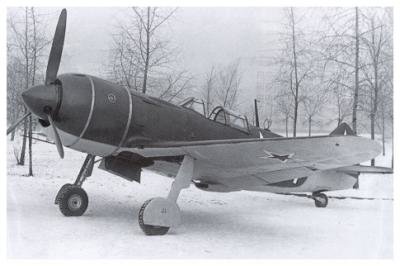The Lavochkin series of fighters were among the best fighters produced during World War II. As a dogfighter the La 5 was considered a superior aircraft to both the German Bf 109 and Fw 190 fighters. The La 5 was the fighter of choice for Soviet aces. Ivan Kozhedub brought down 62 German planes in an La 5FN (a fuel injection version of the La 5).
The Lavochkin’s final World War II variation was the La 7. The La 7 was equipped with a slightly more powerful version of the La 5FN fuel-injected engine. The La 7 was given metal wing spars – the La 5’s were made from wood – so they would be both stronger and lighter. The La 7 was also given a third 20 mm cannon. These three cannons together could spew around 7 lbs ( ) of lead per second. Fuel capacity was cut in half to reduce weight. The La 7 was typically used for low-altitude, front-line skirmishes anyhow so the reduced radius was not considered a severe drawback. For his design of the La 7 and all planes bearing his name, Lavochkin received the esteemed Stalin Prize.
21,975 of the various Lavochkin models were produced. They left service in 1945.
| Type | Fighter |
| Power Plant | 1 x 1,859-horsepower Shvetsov M-82/M-82FN radial engine. |
| Max speed: | 665 Km/h (413 mph) |
| Ceiling: | 10,800 m (35,435 ft.) |
| Range: | 635 km (395 mi.) |
| Weight (empty): | 2,638 kg (5,816 lb.) |
| Weight (loaded): | 3,400 kg (7,496 lb.) |
| Wingspan: | 9.75 m (32 ft. 2 in.) |
| Length: | 8.55 m (28 ft. 2 in.) |
| Height: | 2.83 m (9 ft. 3 in.) |
| Armament: | 2 x 20 mm cannons; up to 441 pounds of bombs |
| Service | 1944 – 1945 |
